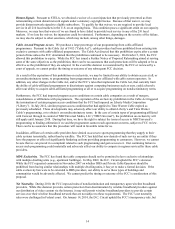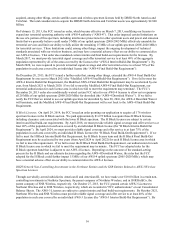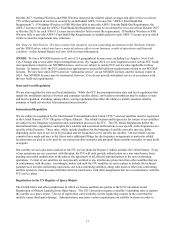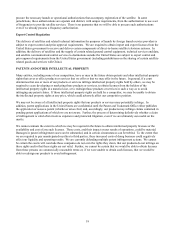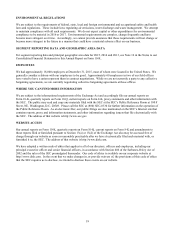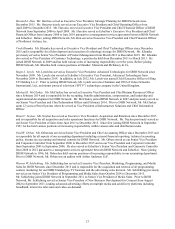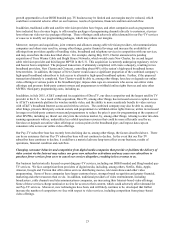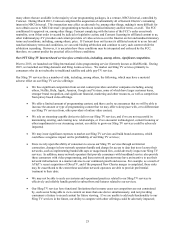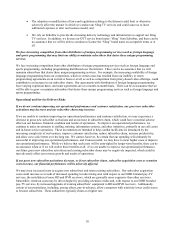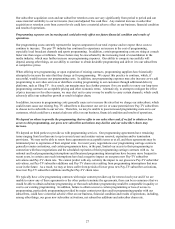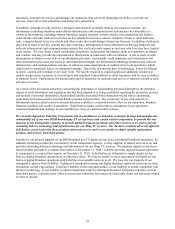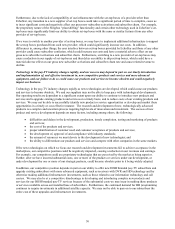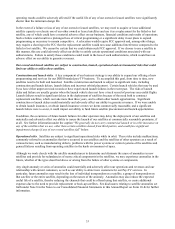Dish Network 2015 Annual Report Download - page 33
Download and view the complete annual report
Please find page 33 of the 2015 Dish Network annual report below. You can navigate through the pages in the report by either clicking on the pages listed below, or by using the keyword search tool below to find specific information within the annual report.23
growth opportunities of our DISH branded pay-TV business may be limited and our margins may be reduced, which
could have a material adverse effect on our business, results of operations, financial condition and cash flow.
In addition, traditional cable and satellite television providers have begun, and other companies such as programmers
have indicated they also may begin, to offer smaller packages of programming channels directly to customers, at prices
lower than our video service package offerings. These offerings could adversely affect demand for our Pay-TV services
or cause us to modify our programming packages, which may reduce our margins.
Moreover, mergers and acquisitions, joint ventures and alliances among cable television providers, telecommunications
companies and others may result in, among other things, greater financial leverage and increase the availability of
offerings from providers capable of bundling video, broadband and telephone services in competition with our services,
and may exacerbate the risks described above. For example, during May 2015, Charter announced its pending
acquisition of Time Warner Cable and Bright House Networks, which would create New Charter, the second largest
cable television provider and third largest MPVD in the U.S. This acquisition is currently undergoing regulatory review
and has not been completed. The proposed transaction, if ultimately completed, will create a duopoly, resulting in two
broadband providers, New Charter and Comcast, controlling about 90% of the nation’s high-speed broadband homes
between them. In addition, the impact of New Charter would cause a significant proportion of the combined company’s
high-speed broadband subscribers to lack access to alternative high-speed broadband options. Further, if the proposed
transaction ultimately is completed, New Charter would be able to, among other things, foreclose or degrade our online
video offerings at various points in the broadband pipe; impose data caps on consumers who access our online video
offerings; and pressure third-party content owners and programmers to withhold online rights from us and raise other
MVPDs’ third-party programming costs, including us.
In addition, in July 2015, AT&T completed its acquisition of DirecTV, our direct competitor and the largest satellite TV
provider in the U.S. As a result of this acquisition, DirecTV, among other things, has increased access to capital, access
to AT&T’s nationwide platform for wireless mobile video, and the ability to more seamlessly bundle its video services
with AT&T’s broadband Internet access and wireless services. The combined company may also be able to, among
other things, pressure third-party content owners and programmers to withhold online rights from us; utilize its increased
leverage over third-party content owners and programmers to reduce the price it pays for programming at the expense of
other MVPDs, including us; thwart our entry into the wireless market, by, among other things, refusing to enter into data
roaming agreements with us; underutilize key orbital spectrum resources that could be more efficiently used by us;
foreclose or degrade our online video offerings at various points in the broadband pipe; and impose data caps on
consumers who access our online video offerings.
Our Pay-TV subscriber base has recently been declining due to, among other things, the factors described above. There
can be no assurance that our Pay-TV subscriber base will not continue to decline. In the event that our Pay-TV
subscriber base continues to decline, it could have a material adverse long-term effect on our business, results of
operations, financial condition and cash flow.
Changing consumer behavior and competition from digital media companies that provide or facilitate the delivery of
video content via the Internet may reduce our gross new subscriber activations and may cause our subscribers to
purchase fewer services from us or to cancel our services altogether, resulting in less revenue to us.
Our business has historically focused on providing pay-TV services, including our DISH branded and Sling branded pay-
TV services. We face competition from providers of digital media, including, among others, Netflix, Hulu, Apple,
Amazon, Google and Verizon that offer online services distributing movies, television shows and other video
programming. Some of these companies have larger customer bases, stronger brand recognition and greater financial,
marketing and other resources than we do. In addition, traditional providers of video entertainment, including
broadcasters, cable channels and telecommunications companies, are increasing their Internet-based video offerings.
Some of these services charge nominal or no fees for access to their content, which could adversely affect demand for
our Pay-TV services. Moreover, new technologies have been, and will likely continue to be, developed that further
increase the number of competitors we face with respect to video services, including competition from piracy-based
video offerings.



